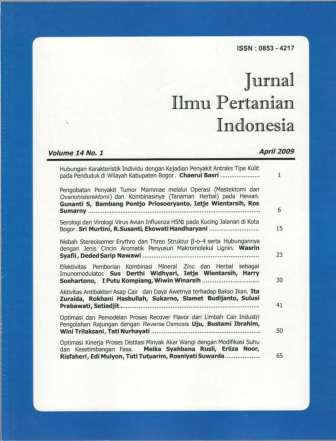Serologi dan virologi virus avian influenza H5N1 pada kucing jalanan di Kota Bogor
Abstract
Highly pathogenic avian influenza (HPAI) H5N1 virus is a known pathogen in birds. Recently, the virus has been reported to cause sporadic fatal disease in tigers, leopards, and other exotic felids as well as domestic cats in Thailand. The present study was carried out to investigate the presence of AI H5N1 virus infection in stray cats roaming around residential, traditional and chicken farms in Bogor, West Java. Ninety serum samples were tested using HI test to screened for the presence of antibody to AI H5N1. Virus isolation was done in SPF embrionated chicken eggs and identify using HI, AGP and RT-PCR. The results showed that 18,9% of stray cats developed antibodies against H5 with geometric mean titre 23,1 . Stray cats lived in traditional markets 18–40% developed antibodies in the titre ranging from 22,8 to 24,5. Only two out of nine stray cats which lived in chicken farm developed low antibody titres again H5 (21). None of the stray cats lived in residencial area have developed antibodies against H5. This study revealed that stray cats have been contact with AI H5. Avian influenza H5 viruses were isolated in eight out of 33 pooled of rectal swab samples. The viral cleavage site sequences are CCTCAAAGAGAGAGC AGAAGAAAGAAGAGAGGT which represent amino acid sequences of PQRESRRKKRG. Based on the cleavage site sequence, the isolates are similar with the AI H5 virus subtype isolated from human in Indonesia during 2005–2007.Downloads
References
[FAO] Food Agricultural Organization. 2006. Animal Health Special Report ; H5N1 in Cats. http://www.fao.org/subjects/en/health/diseases-cards/ avian_cats.html
Nidom, C.A. 2008. Perkembanagn Virus Flu Burung di Indonesia, Workshop Sehari Penelitian Avian Influenza di Indonesia, LIP! Jakarta 4 September 2008
[OIE]. 2005. Manual of standards Diagnostic Tests and Vaccines. http://www.oie.int/ html.
Poovorawan, Y. 2007. Molecular Epidemiology of Avian Influenza H5N1 in Thailand. ScienceAsia 33 Supplement 1 (2007): 87−90
Rimmelzwan, G.F. et al., 2006. Influenza A Virus (H5N1) Infection in Cats Causes Systemic Disease with Potential Novel Routes of Virus Spread Within and Between Hosts. Am. J. Pathol. 168: 176−183.
Shortridge, K.F. et al., 1999. Interspecies Transmission of Influenza Viruses: a Hong Kong Perspective. Symposium On Animal Influenza Viruses, Gent. Belgium 16th−18th May 1999.
Slomka, M.J. et al., 2007. Identification of Sensitive and Spesific Avian Influenza Polymerase Chain Reaction Methods Through Blind Ring Trials Organized In The European Union. Avian Dis. 51: 227−234
Thiry, E. et al., 2007. Highly Pathogenic Avian Influenza H5N1 Virus in Cats and Other Carnivores. Vet Microbiol. 122 :25−31.
Tiensin, T, et al., 2005. Highly Pathogenic Avian Influenza H5N1, Thailand, 2004 Emerging Infectious Diseases • www.cdc.gov/eid •11 : 1664−1672.
This journal is published under the terms of the Creative Commons Attribution-NonCommercial 4.0 International License. Authors who publish with this journal agree to the following terms: Authors retain copyright and grant the journal right of first publication with the work simultaneously licensed under a Creative Commons Attribution-NonCommercial 4.0 International License. Attribution — You must give appropriate credit, provide a link to the license, and indicate if changes were made. You may do so in any reasonable manner, but not in any way that suggests the licensor endorses you or your use. NonCommercial — You may not use the material for commercial purposes.


















